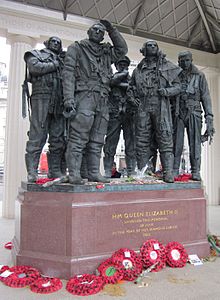
The Battle of Britain was a military campaign of the Second World War, in which the Royal Air Force (RAF) and the Fleet Air Arm (FAA) of the Royal Navy defended the United Kingdom (UK) against large-scale attacks by Nazi Germany's air force, the Luftwaffe. It was the first major military campaign fought entirely by air forces. The British officially recognise the battle's duration as being from 10 July until 31 October 1940, which overlaps the period of large-scale night attacks known as the Blitz, that lasted from 7 September 1940 to 11 May 1941. German historians do not follow this subdivision and regard the battle as a single campaign lasting from July 1940 to May 1941, including the Blitz.

Operation Chastise, commonly known as the Dambusters Raid, was an attack on German dams carried out on the night of 16/17 May 1943 by 617 Squadron RAF Bomber Command, later called the Dam Busters, using special "bouncing bombs" developed by Barnes Wallis. The Möhne and Edersee dams were breached, causing catastrophic flooding of the Ruhr valley and of villages in the Eder valley; the Sorpe Dam sustained only minor damage. Two hydroelectric power stations were destroyed and several more damaged. Factories and mines were also damaged and destroyed. An estimated 1,600 civilians – about 600 Germans and 1,000 enslaved labourers, mainly Soviet – were killed by the flooding. Despite rapid repairs by the Germans, production did not return to normal until September. The RAF lost 56 aircrew, with 53 dead and 3 captured, amid losses of 8 aircraft.
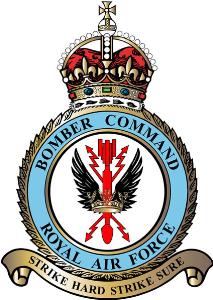
RAF Bomber Command controlled the Royal Air Force's bomber forces from 1936 to 1968. Along with the United States Army Air Forces, it played the central role in the strategic bombing of Germany in World War II. From 1942 onward, the British bombing campaign against Germany became less restrictive and increasingly targeted industrial sites and the civilian manpower base essential for German war production. In total 364,514 operational sorties were flown, 1,030,500 tons of bombs were dropped and 8,325 aircraft lost in action. Bomber Command crews also suffered a high casualty rate: 55,573 were killed out of a total of 125,000 aircrew, a 44.4% death rate. A further 8,403 men were wounded in action, and 9,838 became prisoners of war.

Royal Air Force Digby otherwise known as RAF Digby is a Royal Air Force station located near Scopwick and 11.6 mi (18.7 km) south east of Lincoln, in Lincolnshire, England. The station is home to the tri-service Joint Service Signals Organisation, part of the Joint Forces Intelligence Group of Joint Forces Command. Other units include the RAF Aerial Erector School, No. 54 Signals Unit and No. 591 Signals Unit.

The Handley Page Halifax is a British Royal Air Force (RAF) four-engined heavy bomber of the Second World War. It was developed by Handley Page to the same specification as the contemporary twin-engine Avro Manchester.

A bouncing bomb is a bomb designed to bounce to a target across water in a calculated manner to avoid obstacles such as torpedo nets, and to allow both the bomb's speed on arrival at the target and the timing of its detonation to be pre-determined, in a similar fashion to a regular naval depth charge. The inventor of the first such bomb was the British engineer Barnes Wallis, whose "Upkeep" bouncing bomb was used in the RAF's Operation Chastise of May 1943 to bounce into German dams and explode underwater, with an effect similar to the underground detonation of the later Grand Slam and Tallboy earthquake bombs, both of which he also invented.

Number 617 Squadron is a Royal Air Force aircraft squadron, originally based at RAF Scampton in Lincolnshire and currently based at RAF Marham in Norfolk. It is commonly known as "The Dambusters", for its actions during Operation Chastise against German dams during the Second World War. In the early 21st century it operated the Panavia Tornado GR4 in the ground attack and reconnaissance role until being disbanded on 28 March 2014. The Dambusters reformed on 18 April 2018, and was equipped at RAF Marham in June 2018 with the Lockheed Martin F-35B Lightning, becoming the first squadron to be based in the UK with this advanced V/STOL type. The unit is composed of both RAF and Royal Navy personnel, and operates from the Royal Navy's Queen Elizabeth-class aircraft carriers.

No. 460 Squadron is a Royal Australian Air Force intelligence unit active within the Defence Imagery and Geospatial Organisation (DIGO). It was first formed as a heavy bomber squadron during World War II on 15 November 1941 and disbanded on 10 October 1945 after seeing extensive combat over Europe. The squadron was a multinational unit, but most personnel were Australian. No. 460 Squadron was reformed on 2 July 2010 and is currently located in Canberra.
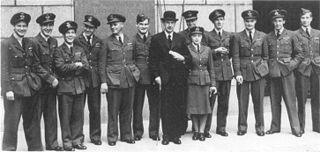
The Few were the airmen of the Royal Air Force (RAF) and the aviators of the Fleet Air Arm, Royal Navy (RN) who fought the Battle of Britain in the Second World War. The term comes from Winston Churchill's phrase "Never, in the field of human conflict, was so much owed by so many to so few." It also alludes to Shakespeare's famous speech in his play, Henry V: "We few, we happy few, we band of brothers..."

No. 5 Group RAF was a Royal Air Force bomber group of the Second World War, led during the latter part by AVM Sir Ralph Cochrane.
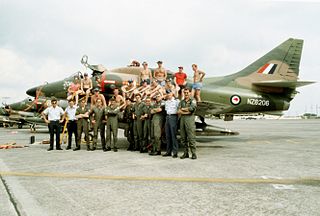
No. 75 Squadron RNZAF was an air combat squadron of the Royal New Zealand Air Force. It was formed from the RAF's World War II bomber squadron, No. 75 Squadron, which had been initially equipped by the New Zealand government and was largely manned by New Zealanders. The squadron was created when, in a unique gesture, the squadron number, colours and battle honours were transferred to the RNZAF in 1946. It had flown more sorties and suffered more casualties than any other in the European theatre.

Royal Air Force Woodhall Spa, or more simply RAF Woodhall Spa, is a former Royal Air Force satellite station located 2 miles (3.2 km) north of Coningsby, Lincolnshire and 16 miles (26 km) southeast of Lincoln, Lincolnshire, England.
Royal Air Force Defford, or more simply RAF Defford, is a former Royal Air Force station located 1.1 miles (1.8 km) northwest of Defford, Worcestershire, England.

Squadron Leader John Leslie Munro, was a Royal New Zealand Air Force pilot during World War II and the last surviving pilot of the Dambusters Raid of May 1943.
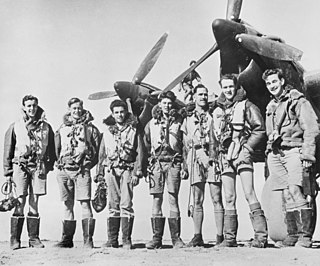
Article XV squadrons were Australian, Canadian, and New Zealand air force squadrons formed from graduates of the British Commonwealth Air Training Plan (1939) during World War II.

426 Transport Training Squadron is a unit of the Canadian Forces under Royal Canadian Air Force, located at CFB Trenton in Trenton, Ontario. It originated as a squadron in the Royal Canadian Air Force (RCAF) that fought during the Second World War as a bomber squadron.

Royal Canadian Air Force Station Jarvis was a Second World War British Commonwealth Air Training Plan (BCATP) station located near Jarvis, Ontario. The station was home to No. 1 Bombing and Gunnery School and is usually known by that name. Bombing and Gunnery schools trained Air Gunners, Wireless Air Gunners, Air Observers, Air Bombers, and Navigator-Bomb Aimers. These airmen served as aircrew on bombers and maritime patrol aircraft.

The aircrews of RAF Bomber Command during World War II operated a fleet of bomber aircraft carried strategic bombing operations from September 1939 to May 1945, on behalf of the Allied powers. The crews were men from the United Kingdom, other Commonwealth countries, and occupied Europe, especially Poland, France, Czechoslovakia and Norway, as well as other foreign volunteers. While the majority of Bomber Command personnel were members of the RAF, many belonged to other air forces – especially the Royal Canadian Air Force (RCAF), Royal Australian Air Force (RAAF) and Royal New Zealand Air Force (RNZAF). Under Article XV of the 1939 Air Training Agreement, squadrons belonging officially to the RCAF, RAAF, and RNZAF were formed, equipped and financed by the RAF, for service in Europe. While it was intended that RCAF, RAAF, and RNZAF personnel would serve only with their respective "Article XV squadrons", in practice many were posted to units of the RAF or other air forces. Likewise many RAF personnel served in Article XV squadrons.

Alexander Ross Sutherland was a Scottish Royal Air Force (RAF) airman. As a teenager he helped establish the Inverness squadron of the Air Training Corps, becoming their first senior non-commissioned officer. Enlisting with the RAF, he became a bombardier/radio operator, flying ten bombing raids over Germany with No. 5 Group RAF in Avro Lancasters during World War II.
Lawrence Seymour Goodman was a British airman and bomber pilot, who served in World War II. He was the last surviving wartime pilot of the No. 617 Squadron RAF which carried out Operation Chastise, although he did not join the squadron until after the operation.
